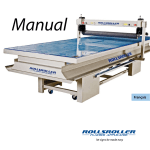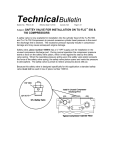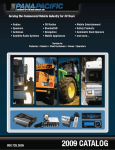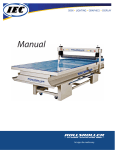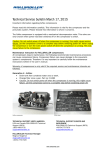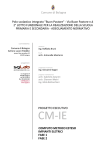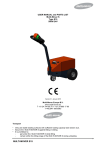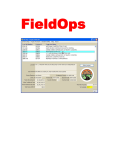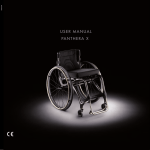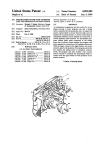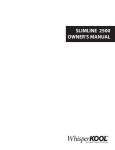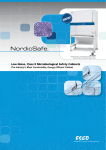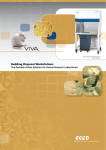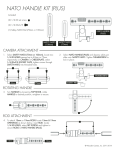Download English - Signs Plus Banners
Transcript
Manual English let signs be made easy 1 General information Table of contents Fingers or hand entanglement. Clamp risk when pressurising the roller. General information 3 Summary 4 Warning symbols 5 Safety 6 Installation, assembly and dismantling 7 Handling 9 Application on detached materials Application of colour on smooth sign surfaces 13 How to mount application tape 17 How to apply graphics to flexible materials 20 Adjustment of the roller speed 23 24 Troubleshooting 24 Repairs 24 Spare parts 24 Technical specifications 25 Consult Technical Manual for proper service procedures. Carefully read Operator’s Manual before handeling the machine. Observe Instructions and saftey rules when operating. The ROLLSROLLER® Flatbed Applicator is specially designed for applying foil and all types of self-adhesive vinyl (e.g. computer cut lettering and digitally printed designs) to a wide variety of materials including sheet metal, plastic, glass, Kapa board and banners. ROLLSROLLER® is designed for dry application of foil and transfer film, and produces a result completely free of bubbles and creases. The machine consists of a table (flatbed) and a gliding beam with a pneumatically activated roller that is moved manually over the flatbed. 9 Maintenance No-text saftey sign “ read operators manual” Before first use of the ROLLSROLLER® Flatbed Applicator, you should carefully read this manual, which contains important instructions, indications and safety information. Failure to read the manual may result in serious injury to operators and damage to the machine. Electrical Shock/electrocution Congratulations! You have just invested in a flat applicator that will make your work significantly more efficient. The ROLLSROLLER® Flatbed Applicator is easy to operate. However, you should still take the time to read through this manual carefully. This will help you to get the best out of your ROLLSROLLER® Flatbed Applicator and minimise risk of injury to the operator and damage to the machine. Good luck with your ROLLSROLLER®. 2 3 Enligt ISO 11684:1995 Move roller up and down. Feet or toe entanglement. Clamp risk when using height adjustment. Adjust working height. Summary To use your ROLLSROLLER® safely, you need to be familiar with the warning symbols in this manual. Enligt ISO 11684:1995 No-text saftey sign “ read operators manual” Consult Technical Manual for proper service procedures. Fingers or hand entanglement. Clamp risk when pressurising the roller. No-text saftey sign “ read operators manual” Carefully read Operator’s Manual before handeling the machine. Observe Instructions and saftey rules when operating. Move roller up and down. Electrical Shock/electrocution Electrical Shock/electrocuti Emergency stop function Reset button Risk of crushing between roller and glass panel. Electrical risks. Media holder Fingers or hand entanglement. Clamp risk when pressurising the roller. Adjust working height. Feet or toe entanglement. Clamp risk when using height adjustment. No-text saftey sign “ read operators manual” Consult Technical Manual for proper service procedures. Carefully read Operator’s Manual before handeling the machine. Observe Instructions and saftey rules when operating. Electrical Shock/electrocution Cutting mat Art no: 10175 Flatbed Feet or toe entanglement. Clamp risk when using height adjustment. Move roller up and down. Feet or toe entanglement. Clamp risk when using height adjustment. Adjust working height. Move roller up and down. Adjust working height. Electrical Shock/electrocution Risk of crushing between floor and legs. Art no: 10176 Power switch Read the manual. Fingers or hand entanglement. Clamp risk when pressurising the roller. No-text saftey sign “ read operators manual” Consult Technical Manual for proper service procedures. Carefully read Operator’s Manual before handeling the machine. Observe Instructions and saftey rules when operating. Fingers or hand entanglement. Clamp risk when pressurising the roller. Move roller up and down. No-text saftey sign read operators manual” Fingers or“ hand entanglement. Clamp risk when pressurising the roller. Carefully read Operator’s Manual before handeling the machine. Observe Instructions and saftey rules when operating. Consult Technical Manual foroperators proper service No-text saftey sign “ read manual” procedures. Carefully read Operator’s Manual before handeling the machine. Observe Instructions and saftey rules when operating. Consult Technical Manual for proper service procedures. Side pocket Art no: 10178 Regulator Adjustment screws Adjust working height. EnligtEnligt ISO 11684:1995 ISO 11684:1995 Control lever Art no: 10174 Emergency stop function Glide beam Roller Consult Technical Manual for proper service procedures. Carefully read Operator’s Manual before handeling the machine. Observe Instructions and saftey rules when operating. Feet or toe entanglement. Clamp risk when using height adjustment. Manometer Adjust working height. Warning symbols Fingers or hand entanglement. Clamp risk when pressurising the roller. Control lever Move roller up and down. Feet or toe entanglement. Clamp risk when using height adjustment. Electrical Shock/electrocution Height-adjustable roller. Art no: 10177 4 Art no: 10180 Electrical Shock/electrocution Contact a technician. Art no: 10179 5 Enligt ISO 11684:1995 Safety Installation, assembly and dismantling Emergency situations When the roller is pneumatically pressed against the flatbed, there is a risk of crushing and catching. Take care when operating the ROLLSROLLER®, especially if more than one operator is using it. In the event of an emergency, use the available emergency stop functions. When the emergency stop is activated, the pneumatic cylinders are depressurised and return to the idle position Move roller up and down. Feet or toe entanglement. (this means that the roller moves upwards). Before the equipClamp risk when using height adjustment. ment can be used again after an emergency stop, you must switch the control levers to the neutral position, turn the emergency stop knob anti-clockwise and press in the reset button. Personal safety equipment No personal safety equipment is required. Testing of safety functions The safety functions should be tested in connection with installation, servicing, maintenance etc. These include the emergency stop function and the mechanical stop function for the glide beam. Fingers or hand entanglement. Clamp risk when pressurising the roller. No-text saftey sign “ read operators manual” Carefully read Operator’s Manual before handeling the machine. Observe Instructions and saftey rules when operating. Remaining risks Consult technical manual for proper service procedures Positioning Delivery inspection Before use The following units are included when the machine is delivered: • Manual • Scissors • ROLLSROLLER® Flatbed Applicator Clean and lubricate the sliding bars. The ROLLSROLLER® Flatbed Applicator should be placed on an even, moisture-free, vibration-free surface. After use Place the roller in the idle position (raised 5 mm above the flatbed). Consult Technical Manual for proper service procedures. Connections Voltage: Air connection: Electrical Certain risks cannot be eliminated through technical safety measures alone. There is a risk of crushing and catching when the roller is pneumatically pressed against the flatbed. A warning symbol is displayed on or immediately beside the glide beam. There is a risk of severe crushing and catching when the roller is pneumatically pressed against the supporting bars. Never pressurise the roller without first ensuring that the sign material is positioned underneath the roller. Read operators manual The ROLLSROLLER® Flatbed Applicator should be assembled and used at normal room temperature with normal humidity levels. This minimises the occurrence of static electricity. Adjust working height. Read operators manual Consult technical manual for proper service procedures 230 V AC 50 Hz, available in US version 110 V AC 60 Hz max. 8 bar, filtered, moisture-free air. 3–4 bar used during operation. ROLLSROLLER® Flatbed Applicator with unmounted glide beam Assembly may only be performed by the supplier or staff authorised by the supplier. Shock/electrocution Electrical connectors may only be connected to sockets with the correct voltage. All other operations may only be performed by authorised staff. ROLLSROLLER® Flatbed Applicator with mounted glide beam 1. Remove the protective film/packaging. 2. Remove the strips holding the glide beam in place. Fingers or hand entanglement Electrical Shock/electrocution A red emergency stop button is located at either end of the glide beam. (ROLLSROLLER® models 280 and 340 have only one emergency stop button located at the centre of the glide beam.) Unauthorised use The machine may only be used for its intended purpose as specified in this manual. All other use may result in damage or injury, and is at the user’s own risk. exempel sid 42 bild som visar om det finns särskild risk för ström behövs kanske inte ?? 6 Fingers or hand entanglement 7 exempel sid 42 Lifting instructions Height-adjustable table The ROLLSROLLER® should be lifted with a pallet lift or a forklift fitted with long forks, with a minimum fork length of 1,700 mm and minimum lifting capacity of 1,000 kg (2,200 mm for ROLLSROLLER® models 540/220). The forks must be positioned within the specified lifting area (see picture below). If your ROLLSROLLER® is height-adjustable, use the buttons on the long side of the table to achieve the optimum ergonomic working height. Handling No specific training is required to use the ROLLSROLLER® Flatbed Applicator. This user manual contains all the necessary instructions for use. Application on detached materials 1. For application on thick materials, for instance bent metal Oil 2. Place the metal sheet on a section of polystyrene or similar sheets, position the material in the centre of the table. material to stabilise the sign and distribute the pressure. After adjusting the table’s height, you must wait 60 seconds before using the height adjustment function again. If a problem occurs, the height adjustment function can be reset by pressing and holding the “down” button until a click is heard. To lubricate the sliding bars, use oil WD 40 or CRC 5-56, or an equivalent oil. For the compressor P30/6, use oil SINCOM/32E or equivalent. 8 3. Place the graphic on the substrate and measure to the exact 4. Using the control lever on the top of the machine, press the size. 9 roller against the substrate to fix the graphic into place. 6. Peel off the liner from the half that is above the roller. 5. Fold half of the graphic over the roller. 9. Apply one half of the graphic to the substrate. When you get right to the edge, raise the roller slightly so that it does not roll onto the table. Always make sure that the graphic is pres- sed against the roller before starting application. 10. Place the glide beam at the point where the liner was cut. Pressurise the roller. 12. Take hold of the liner that you folded in from the other side. 7. Cut the liner, leaving a surplus border of about 10 cm. 8. Fold the liner back underneath the roller to form an even 10 pleat, as shown in picture. Move the glide beam over the surface. Always make sure that the graphic is pressed against the roller before starting application. 11. Fold the other half of the graphic over the roller. 11 Application of graphic film on flat sign surfaces 13. Apply the remaining part of the design to the substrate using the roller. Always remember to raise the roller slightly when it gets to the edge. 14. 1. Place the sign material at the centre of the table and pull 2. Cut the graphic film to the appropriate length. the graphic film over the substrate. 16. The result: a smooth sign without creases or bubbles. 15. Trim to size if the graphic is larger than the substrate. 3. Press the roller against the substrate to fix the graphic film 12 into place. 4. Fold half of the graphic film over the roller. 13 5. Peel off the liner from the graphic film at a 45 degree angle. 6. Cut the liner, leaving a surplus border of about 10 cm. 7. Fold the liner back underneath the roller ... 8. ... so that it forms an even pleat. 9. Apply one half of the graphic film using the roller. Always 10. Press the roller down at the point where you cut, and fold the other half of the foil over the roller. make sure that the graphic is pressed against the roller before starting application. 11. Take hold of the part of the liner that you folded under- 12. ... and peel off the liner. neath the roller ... 14 15 How to mount application tape 2. Pull out a length of application tape and fold it over the roller. 13. Apply the other half of the graphic film using the roller. 14. Trim. Always make sure that the graphic is pressed against the roller before starting application. 1. Place a roll of application tape in the media holder. Choose whether or not you want to use a core holder. 15. You have now finished applying the graphic film. 4.... and align it with the edge of the roll to ensure even appli- 3. Take hold of the application tape underneath the roller ... 16 17 cation 10. Push the glide beam back, press the roller down and apply the last piece of tape in the opposite direction. 5. Press the roller down while keeping hold of the roll. 6. Move the roller forwards about 10 cm. 9. Trim before applying the last piece of tape. If you are apply ing tape to several graphics simultaneously, raise the roller and repeat the first steps in the same way as for the first graphics. 8. Raise the roller and pull it forwards slightly until the roller is 7. Place the graphic film beside the application tape. 18 positioned above the graphic. Make sure that the graphic is lying flat when you press the roller down. Now apply the tape over the graphic. Stop about 10 cm before reaching the end of the graphic. 11. Trim. 19 How to apply graphics to flexible materials 2. Place the graphic on the substrate and measure to the exact 1. Flatten the substrate using the roller. 5. Peel off the liner. 6. Cut the liner, leaving a surplus border of about 10 cm. size. 8. Apply half of the graphic using the roller. Press the roller 3. Press the roller down to fix the graphic into place. 4. Fold half of the graphic over the roller. 20 7. Fold the liner underneath the roller. Make sure it forms an even pleat. 21 down against the substrate. Feet or toe entanglement. Clamp risk when using height adjustment. Move roller up and down. Adjust working height. Adjustment of the roller speed Fingers or hand entanglement. Clamp risk when pressurising the roller. No-text saftey sign “ read operators manual” If you want the roller to move faster or slower, you can adjust the speed. Please note that this is normally not necessary, since the speed is preset at the factory. Consultroller Technical Manual for proper service procedures. Carefully read Operator’s Manual before handeling the machine. Observe Instructions and saftey rules when operating. Electrical Shock/electrocution Contact a technician. 10. Take hold of the piece of liner you folded underneath the roller. 9. Fold the other half over the roller. 12. Remove the application tape, using the roller to hold the material in place. 11. Apply the other half of the graphic using the pressurised roller. 22 1.Use the two adjustment screws on either side of the glide beam. Unfasten the grooved lock nut. The lower screw reduces the speed and the upper screw increases the speed. Adjust the screws to the desired speed on one side. Change sides and adjust on the other side so that the roller can be lowered flat against the table. Lock with the lock nut. 23 Maintenance Technical specifications Every day The machine pulls unevenly during application • Make sure that the roller is not damaged and has nothing stuck to it. • Check the emergency stop function and controls. Contact a technician. Enligt ISO 11684:1995 ROLLSROLLER® 280/145 MDF ROLLSROLLER® 280/145 ROLLSROLLER® 340/145 Overall length 2 800 mm 2 800 mm 3 400 mm Overall width 1 710 mm 1 710 mm 1 710 mm The table’s height adjustment function doesn’t work Bed width 1 450 mm 1 450 mm 1 450 mm If there are problems with the height adjustment function, you can reset the function by pressing and holding the “down” button until a click is heard. If this doesn’t help, contact a technician. Overall height 1 520 mm 1 520 mm 1 520 mm Length of working area 2 500 mm 2 500 mm 3 100 mm Width of working area/roller width 1 400 mm 1 400 mm 1 400 mm 60 mm 60 mm 60 mm • Lubricate the sliding bar’s slide surfaces. • If your ROLLSROLLER has a compressor, see enclosed ma- nual for maintenance instructions. Repairs Working height, standard model 920 mm 920 mm 920 mm 170 kg 270 kg 320 kg MDF glass glass As necessary Contact a technician. Cutting mat, 4 mm yes yes yes Side pockets no no no Illumination not illuminated 6x36W fluorescent 9x36W fluorescent - 230 volt/50 Hz ** 230 volt/50 Hz ** Once a week • Wipe any dust off the glide beam’s sliding bar. Once a month Feet or toe entanglement. Clamp risk when using height adjustment. • • Check the bearing play in the glide beam (contact a technician). Dust the cutting mat with talcum powder. (The cutting mat is dusted with talcum powder at the fac- tory, but should be dusted again when it is turned, to prevent vinyl or other materials from fastening on the mat. Spread talcum powder on the mat and distribute it with a window scraper. Vacuum or sweep off any surplus talcum powder and wipe the mat with a dry cloth.) Move roller up and down. Weight Adjust working height. You should first try contacting a technician through the dealer where you bought your ROLLSROLLER®. If this is not possible, contact ROLLSROLLER® Technical Service, phone +46 54 770 70 70. Fingers or hand entanglement. Clamp risk when pressurising the roller. No-text saftey sign “ read operators manual” Max. thickness of sign substrate (standard)* Consult Technical Manual for proper service procedures. Carefully read Operator’s Manual before handeling the machine. Observe Instructions and saftey rules when operating. Bed surface Voltage Air pressure 6–8 bar required 6–8 bar required 6–8 bar required Media holder for end of bed optional optional optional Height-adjustable, 750–1,100 mm optional optional optional - - - optional optional optional Additional glide beam with roller Low-noise compressor, 45 db The equipment may only be used for its intended purpose as specified in this manual. All other use may result in damage or injury, and is at the user’s own risk. Electrical Shock/electrocution Troubleshooting * The roller height is adjusted pneumatically (max. 60 mm) and moved manually across the working area. The operator can stand on either side of the table. Rollers that can be adjusted to handle materials thicker than 60 mm (max. 100 mm) can be supplied on request (does not apply to ROLLSROLLER® 280 and 340). ** Available in US version with 110 V AC 60 Hz. The rubber roller won’t move up and down Reset the emergency stop function Reset the controls Activate the reset button Check the air connections If none of this helps, contact a technician. Spare parts You can download a list of spare parts at www.rollsroller.se. Alternatively, contact the dealer where you bought your ROLLSROLLER. 24 25 Technical specifications Technical specifications ROLLSROLLER® 400/150 Overall length 4 000 mm ROLLSROLLER® 400/170 4 000 mm ROLLSROLLER® 540/170 5 400 mm ROLLSROLLER® 540/220 Overall length 5 400 mm ROLLSROLLER® 605/170 6 050 mm ROLLSROLLER® 1080/170 10 080 mm Overall width 1 760 mm 1 960 mm 1 960 mm Overall width 2 460 mm 1 960 mm 1 960 mm Bed width 1 500 mm 1 700 mm 1 700 mm Bed width 2 200 mm 1 700 mm 1 700 mm Overall height 1 520 mm 1 520 mm 1 520 mm Overall height 1 520 mm 1 520 mm 1 520 mm Length of working area 3 600 mm 3 600 mm 5 000 mm Length of working area 5 000 mm 5 650 mm 10 400 mm Width of working area/roller width 1 400 mm 1 630 mm 1 630 mm Width of working area/roller width 2 050 mm 1 630 mm 1 630 mm 60 mm 60 mm 60 mm 60 mm 60 mm 60 mm 920 mm 920 mm 920 mm 920 mm 920 mm 920 mm 650 kg 725 kg 800 kg 950 kg 850 kg 1 630 kg glass glass glass glass glass glass Max. thickness of sign substrate (standard)* Working height, standard model Weight Bed surface Max. thickness of sign substrate (standard)* Working height, standard model Weight Bed surface Cutting mat, 4 mm yes yes yes Cutting mat, 4 mm yes yes yes Side pockets yes yes yes Side pockets yes yes yes Illumination Illumination 20x36W fluorescent tubes 16x36W fluorescent tubes + 4x18W fluorescent tubes 32x36W fluorescent tubes Voltage 230 volt/50 Hz ** 230 volt/50 Hz ** 230 volt/50 Hz ** Air pressure 6–8 bar required 6–8 bar required 6–8 bar required yes yes yes optional optional optional 9x36W fluorescent tubes 12x36W fluorescent tubes 16x36W fluorescent tubes Voltage 230 volt/50 Hz ** 230 volt/50 Hz ** 230 volt/50 Hz ** Air pressure 6–8 bar required 6–8 bar required 6–8 bar required yes yes yes Height-adjustable, 750–1,100 mm optional optional optional Additional glide beam with roller optional optional optional Low-noise compressor, 45 db optional optional optional Media holder for end of bed * The roller height is adjusted pneumatically (max. 60 mm) and moved manually across the working area. The operator can stand on either side of the table. Rollers that can be adjusted to handle materials thicker than 60 mm (max. 100 mm) can be supplied on request (does not apply to ROLLSROLLER® 280 and 340). Media holder for end of bed Height-adjustable, 750–1,100 mm Additional glide beam with roller optional optional optional Low-noise compressor, 45 db optional optional optional * The roller height is adjusted pneumatically (max. 60 mm) and moved manually across the working area. The operator can stand on either side of the table. Rollers that can be adjusted to handle materials thicker than 60 mm (max. 100 mm) can be supplied on request (does not apply to ROLLSROLLER® 280 and 340). ** Available in US version with 110 V AC 60 Hz. ** Available in US version with 110 V AC 60 Hz. 26 27 Patent registration numbers: SE 9702032-5, AU 730769, CA 2, 289, 469, CH 0986459, CN ZL 98805672.0, DE 69826655.0-08, EU, F, I, GB 0 986 459, E ES2230695T3, GR 20040404376, II 132849, MX 209756, N 315014, RU 2220050, TR 199902925B, USA 6, 102, 096, 6, 406, 582 www.rollsroller.se Januari 2009 ROLLSROLLER® is manufactured by Reklamidé Frögatan 3, 653 43 Karlstad, Sweden • Tel. +46 54 770 70 00 • E-mail: [email protected]















